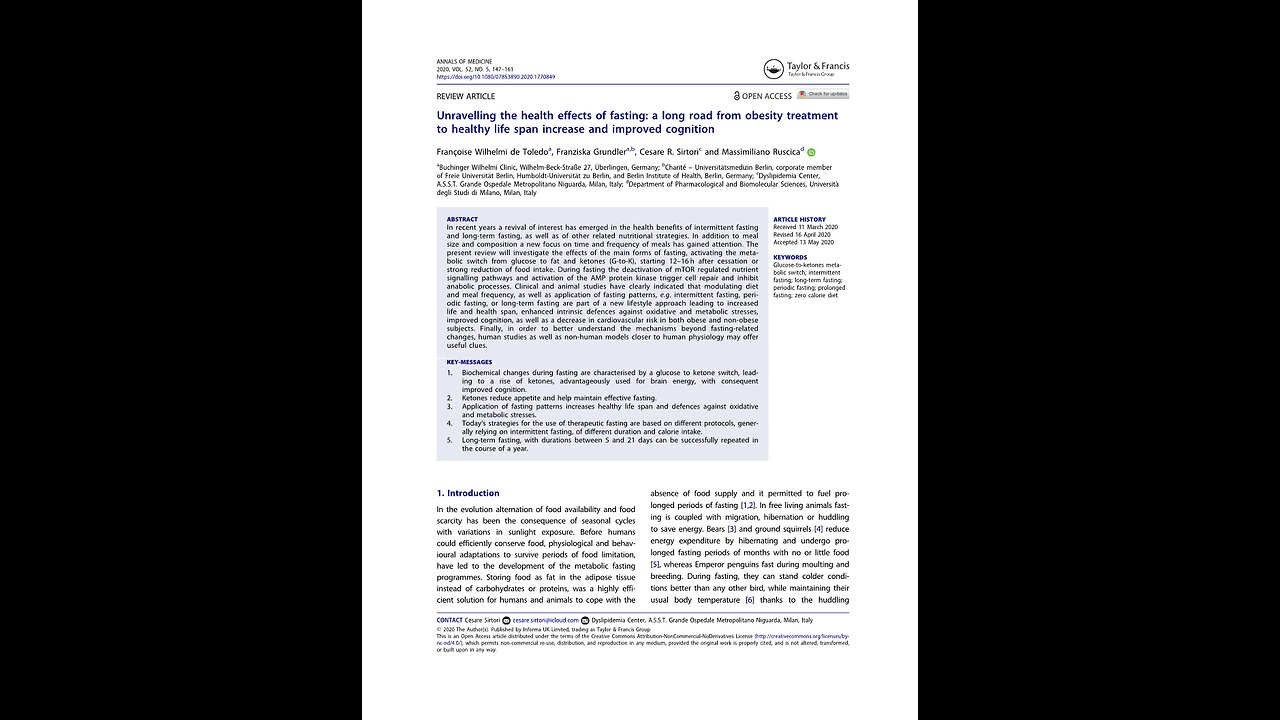Premium Only Content

Unravelling the health effects of fasting, 2020 Françoise Wilhelmi de Toledo, and others.
https://doi.org/10.1080/07853890.2020.1770849
Index of Science Articles:
https://rumble.com/v3t4yzj-index-of-science.-music-by-dan-vasc.html
Unravelling the health effects of fasting: a long road from obesity treatment to healthy life span increase and improved cognition. Annals of medicine 2020, Volume 52, Number 5, pages 147 to 161.
Françoise Wilhelmi de Toledo, and others.
Buchinger Wilhelmi Clinic, Wilhelm-Beck-Strasse 27, Uberlingen, Germany.
In recent years a revival of interest has emerged in the health benefits of intermittent fasting and long-term fasting, as well as of other related nutritional strategies. In addition to meal size and composition a new focus on time and frequency of meals has gained attention. The present review will investigate the effects of the main forms of fasting, activating the metabolic switch from glucose to fat and ketones (G-to-K), starting 12 to 16 hours after cessation or strong reduction of food intake. During fasting the deactivation of m-TOR regulated nutrient signalling pathways and activation of the AMP protein kinase trigger cell repair and inhibit anabolic processes. Clinical and animal studies have clearly indicated that modulating diet and meal frequency, as well as application of fasting patterns, for example, intermittent fasting, periodic fasting, or long-term fasting are part of a new lifestyle approach leading to increased life and health span, enhanced intrinsic defences against oxidative and metabolic stresses, improved cognition, as well as a decrease in cardiovascular risk in both obese and non-obese subjects. Finally, in order to better understand the mechanisms beyond fasting-related changes, human studies as well as non-human models closer to human physiology may offer useful clues.
KEY-MESSAGES.
1. Biochemical changes during fasting are characterised by a glucose to ketone switch, leading to a rise of ketones, advantageously used for brain energy, with consequent improved cognition.
2. Ketones reduce appetite and help maintain effective fasting.
3. Application of fasting patterns increases healthy life span and defences against oxidative and metabolic stresses.
4. Today’s strategies for the use of therapeutic fasting are based on different protocols, generally relying on intermittent fasting, of different duration and calorie intake.
5. Long-term fasting, with durations between 5 and 21 days can be successfully repeated in the course of a year.
1. Introduction.
In the evolution alternation of food availability and food scarcity has been the consequence of seasonal cycles with variations in sunlight exposure. Before humans could efficiently conserve food, physiological and behavioural adaptations to survive periods of food limitation, have led to the development of the metabolic fasting programmes. Storing food as fat in the adipose tissue instead of carbohydrates or proteins, was a highly efficient solution for humans and animals to cope with the absence of food supply and it permitted to fuel prolonged periods of fasting. In free living animals fasting is coupled with migration, hibernation or huddling to save energy. Bears and ground squirrels reduce energy expenditure by hibernating and undergo prolonged fasting periods of months with no or little food, whereas Emperor penguins fast during moulting and breeding. During fasting, they can stand colder conditions better than any other bird, while maintaining their usual body temperature thanks to the huddling behaviour.
Birds can undertake strenuous efforts during long distance migration, while flying hundreds of kilometres without food or drink. Humans also had to adapt to natural cycles of food scarcity for millions of years and only with the onset of agriculture in the Neolithic era, more continuous food supply became available. This culminated in today’s technologies allowing humans in privileged countries to have access to any type of food at any time during the whole year. Extreme situations such as famine, chronic malnutrition, hunger strikes or long course of anorectic denial of food have also provided information about the human capacity to cope with long periods of food shortage. In addition to being a necessity for human survival, the ability to fast has been known in most religions as traditionally ritualised periods lasting from hours to weeks. Religions used fasting empirically for its effects on mind and body, as well as an important factor in community cohesion. In medicine fasting for 2 to 21 days or more was known for its numerous therapeutic effects that led to multidisciplinary fasting programmes, well-known in the public less in the scientific community. Total fasting safely practiced for 31 days has been documented scientifically at the beginning of the twentieth century. Later on, in the nineteen sixties, as obesity started to be a medical issue on a large scale, water fasting to treat morbid obesity and co-morbidities emerged under the names of zero calorie diet or total fasting. The effects of this type of fasting, lasting weeks or months, particularly on obesity, have been extensively documented.
Nowadays a revival of the interest for fasting emerges from a different perspective. Instead of focussing only on weight loss in morbid obesity, the new focus is on the effects of the main fasting regimens, that activate the metabolic switch from liver derived glucose to adipose cell-derived ketones (G-to-K) and its reversal K-to-G, on longevity, health span expansion, multi-stress resistance and antioxidant defence stimulation, improved performance and cellular regeneration in animal models and humans.
The present review investigates, in animal models and humans, how application of several types of fasting strategies, for example intermittent fasting, periodic fasting, or long-term fasting could be part of a new medical approach leading to improved healthy life span and cognition, as well as to a decrement in cardiovascular risk in both obese and non-obese subjects.
2. Fasting classification.
Fasting is defined as the voluntary abstinence or strong limitation of caloric ingestion for a limited period of time, triggering the G-to-K switch and major changes in the activity of signalling pathways. Further effects also take place on refeeding when the K-to-G switch occurs. The big challenge when it comes to classify fasting regimens is that duration has a very different meaning if we consider animals, such as nonobese mice, or humans. One day fasting brings the mouse almost to starvation, ketones decrease and protein catabolism increases, whereas a day in humans is considered as intermittent fasting.
Table 1 summarizes the main forms of fasting and other restrictive diets. Calorie restriction (CR) refers to a daily reduction by 15 to 40 percent of calorie intake without malnutrition. Intermittent fasting (IF) refers to fasting lengths between 16 and 48 hours, alternated with usual food intake.
The most frequently studied IF procedure is alternate day fasting, ADF, whereby normal food intake occurs on one day and restricted food the next day. Time restricted eating-feeding, TRE-TRF, is characterised by intake of food occurring within a time window of 8 to 12 hours per day or less. Periodic fasting (PF) describes cycles of fasting or calorie restricted diets, meaning 5 to 2 diet (5 to 2), referring to two days per week, consecutive or not, in which food intake is drastically reduced to approximately 600 kcal. In some classifications 5 to 2 is considered as IF. Periods of fasting lasting from many days to weeks have sometimes been referred to as periodic and can be repeated every year. Other Authors referred to them as long-term or prolonged fasting.
Considering that these adjectives do not take into consideration differences in the baseline nutritional status and between species, in the present review article we refer to long-term fasting (LF) as a food abstinence from 2 to 21 days or more during which no or minimal amounts of calories, up to 200 to 250 kcal per day are given within appropriate schedules. LF has been well documented in obese and non-obese subjects as well as in animals and during the nineteen sixties in morbidly obese subjects. Other regimens, derived from fasting strategies, are the very-low-calorie diets (VLCD), a hypocaloric formula diet providing 80 to 100 grams of proteins and an average of 1000 kcal per day, designed to treat obesity and to avoid a negative nitrogen balance. Furthermore, the fasting mimicking diet (FMD) is a hypocaloric (800 to 1100 kcal), low protein, ketogenic diet leading to weight loss and to some of the effects of fasting. It is worth mentioning that nutrient restricted normo caloric diets like the ketogenic diet (carbohydrate restriction) and the protein or amino acid (methionine) restricted diet are being also intensively evaluated.
3. Metabolic and cellular responses to fasting.
3 point 1. The metabolic switch.
The onset of fasting is characterised by the metabolic switch, that defines the fuel switch occurring when an organism commutes from the eating mode, including generally around 50percent carbohydrates, to the fasting mode. From 12 to 16 hours after interrupting food absorption, glucose levels drop, followed by a decrease of insulin levels and at the same time of circulating amino acid levels. The onset of the metabolic switch depends on the liver glycogen content at the beginning of the fast as well as on the composition of the preceding meal, energy expenditure, and physical activity. Lipids in adipocytes (triacylglycerol and diacylglycerol) are metabolised to free fatty acids (FFAs) whose levels increase in fasting blood, to be partly oxidised in most tissues, such as muscles, kidneys, heart and partly transformed in the liver to ketones (b-hydroxybutyrate, acetoacetate and acetone). Ketones are not only fuels, since they have also signalling effects and regulate expression and activity of transcription factors like the peroxisome proliferator activated receptor c coactivator 1a (PGC-1a), sirtuins (SIRTs), poly-adenosine diphosphate ADP-ribose polymerase 1 (PARP1), and ADP ribosyl cyclase, as well as fibroblast growth factor 21 and nicotinamide adenine dinucleotide, NAD plus. A rise of brain derived neurotrophic factor (BDNF) in the central nervous system (CNS) can enhance brain health. Ketones are effectively oxidised by the fasting brain, more reluctant than other tissues to renounce glucose and metabolise FFA’s. The use of FFA’s and ketones as energy sources reduces the respiratory exchange ratio (RER), compared with the fed state, indicating a greater metabolic efficiency of energy production during weight loss leading to ketosis.
The decreased ATP to AMP ratio will activate AMP-activated protein kinase (AMPK) as well as create a mild oxidative eustress leading to the activation of antioxidant and cytoprotective enzymes, meaning superoxide dismutase, catalase, peroxidase, sulfiredoxin 1, thioredoxin reductase 1, haem oxygenase-1, NAD(P)H quinone oxidoreductase 1, glutamate-cysteine ligase, glutathione S-transferases, and uridine 50-diphosphoglucuronosyltransferases.
During prolonged periods of fasting, ketosis has been shown to reach a plateau after 4 days, an effect that can last for several hours or days, and to decrease when food is reintroduced, see Figure 1. The G-to-K switch is the key mechanism allowing to spare proteins by reducing protein utilisation, as reflected by the changes in nitrogen balance. It is regulated by inhibition of the m-TOR, mechanistic-mammalian target of Rapamycin, signalling pathway, thus decreasing protein synthesis and enhancing autophagy, that leads to the recycling of endogenous proteins. Relying on ketones for energy during weight loss has the advantage of promoting retention of lean mass; the same may not occur after plain CR. This conclusion was not supported in the most extensive ADF studies to date. At present, the substantial benefit of fasting regimens on lean mass retention needs to be reconsidered.
While the adaptation to long-term fasting can promote lean mass retention, this has not been definitely shown to occur preferentially after IF rather than with CR. It should be noted that ketosis can be also obtained with low energy and-or high fat diets. Normocaloric strict high fat ketogenic diets are successfully prescribed to epileptic children who do not respond to drug treatments.
Switching from a carbohydrate to a lipid rich diet has been successfully applied for weight reduction, although, based on current evidence, low-CHO and very-low-CHO diets do not appear to be clearly superior to other dietary approaches. Ketones serve as an energy source, being metabolised to acetyl coenzyme A (AcCoA) entering the tricarboxylic acid cycle generating adenosine triphosphate (ATP). They sustain the function of muscle and brain cells during fasting as well as extended periods of physical exertion.
Furthermore, ketosis leads to a fully compensated acidosis, believed to be responsible for the characteristic absence of hunger during fasting. Absence of hunger enhances compliance. Blood glucose stabilises at the lower normal level and will remain stable during the whole fasting period, as long as fat reserves can fuel metabolism and the protein pool remains at the physiological limits.
Concomitantly, in a well-orchestrated manner, an increase in the hormonal secretion of glucagon, stimulation of glycogenolysis and gluconeogenesis, growth hormone, implicated in lipolysis, cortisol and adrenaline regulate the course of fasting.
Furthermore, along with a decrement in the adipokine leptin and a rise in adiponectin, fasting significantly reduces insulin like-growth factor, IGF-1. Only restrictions of 50 percent or more of normal daily energy requirements can reduce IGF-1 levels. Low levels of IGF-1 reduce the intracellular mitogenic signaling pathways, and lead mammalian cells to enter either a non-dividing or a low-dividing state and invest energy resources into cellular protection against various insults (multi-stress resistance).
Since during fasting very few or no exogenous proteins or sugars enter the system, nutrient dependent signalling pathways are shut down, m-TOR and Rasadenylate cyclase (AC)-protein kinase A (PKA), along with the de-repression of transcription factors for example SIRT, and forkhead box O1 (FOXO1), leading to the many peculiar features of the fasting mode. The promotion of the multi-stress resistance is characterized by improved antioxidant defences, increased DNA repair and diminished inflammation. Moreover, most cardiovascular risk factors, waist circumference, lipids, blood pressure and insulin resistance, are improved by CR, IF or LF.
The fasting mode will be reversed as soon as a mixed diet is reintroduced, triggering the K-to-G switch: glucose and insulin levels increase, ketones drop, m-TOR is reactivated leading to increased protein synthesis and mitochondrial biogenesis, as well as decreased autophagy.
Cell regeneration in multiple systems occurs, with increased mesenchymal and progenitor cells. In this refeeding phase, specific effects take place concomitant to cell growth and plasticity, leading to functional tissue remodelling and offering a unique opportunity, in adult life, to boost cellular and tissue regeneration. In some cases, an inappropriate pattern of food reintroduction can lead to relapse of symptoms, as seen in the case of LF prescription to treat polyarthritis.
3.2. Signalling pathways modulated by fasting.
In the fasting mode, cellular and metabolic processes are controlled by a complex network of transcriptional regulators. Major regulators are SIRTs, nuclear factor erythroid 2 related factor 2 (NRF2), FOXO1, nuclear factor ‘kappa-light-chain-enhancer’ of activated b-cells (NFkB), hypoxia inducible factor 1 a (HIF-1a), heat shock factor (HSF-1). The decrease of the protein responsive signalling pathway m-TOR and of its downstream effector, the ribosomal protein S6 kinase b-1, leads to global protein synthesis inhibition and recycling of macromolecules by autophagy stimulation. In the brain, in addition to raised neuronal stress resistance through bolstered mitochondrial function there is an improvement in antioxidant defences, DNA repair, and stimulation of BDNF production.
BDNF regulates hippocampal neurogenesis, dendrite morphology and synapse plasticity, and increases production of new neurons from neural stem cells.
The decrease in glucose levels in parallel to the rise in ketones during fasting is associated with a decrement in the glucose responsive Ras-AC-PKA pathway, implicated in life span extension.
Other crucial consequences of fasting are the decrease in insulin-IGF-1 signalling, leading to a reduction in anabolic processes and decrement in the ATP to AMP ratio with consequent activation of AMPK. This last step triggers repair and inhibition of the anabolic processes, Figure 2. Another mechanism associated to the fasting-induced activation of AMPK is autophagy of muscle cells, a process preserving blood glucose levels during LF. As a proof-of-concept, the selective skeletal muscle depletion of AMPK resulted in hypoglycaemia and hyperketosis, an effect not due to an impairment in fatty acid oxidation, but instead to a reduction in autophagy of muscle cells, leading to reduced circulating levels of alanine, an essential amino acid required for gluconeogenesis.
Among the many activated transcriptional regulators quoted above, hepatic SIRT1 protein levels are raised during fasting and reduced with refeeding. SIRT1-driven deacetylation of PGC-1a and the increased FOXO1 transcription factor provides a mechanism by which mitochondrial and lipid oxidation genes can be dynamically controlled in response to energy demand. A specific liver knock down of SIRT1 results in a decreased fasting-dependent downregulation of the lipogenic gene expression (SREBP-1c), suggesting this mechanism for the regulation by SIRT1 of multiple SREBP-1 target genes.
SIRT1 suppresses glucose production by inhibiting the CREB regulated transcription coactivator 2 (CRTC2)-mediated gluconeogenesis, activated during the G-to-K switch. Similar to SIRT1, the mitochondrial deacetylase SIRT3 regulates metabolic homeostasis during fasting and CR. SIRT3 is critical for fatty acid oxidation and ketogenesis during fasting, by regulating the deacetylation state and the activity of mitochondrial enzymes involved in the metabolic switch. Having thus a major role in liver ketogenesis, mice lacking SIRT3 display lower plasma b-hydroxybutyrate levels during fasting.
4. Evidence from experimental animals.
The life and health span extension produced by CR has been an area of interest since the late nineteen seventies. Compared to mice assigned to an ad libitum regimen, 30percent CR and TRF (single-meal feeding) enhanced longevity, regardless of diet composition and showed improvements in morbidity and mortality.
Prevention of age-related declines, as evaluated by tests of motor coordination (rotarod) and learning (complex maze) took place in mice exposed to a 50 percent CR regimen. Increased locomotor activity in a runwheel cage, regardless of age was observed, without effects on exploratory activity in a novel arena. This type of functional improvement has been related to anatomical changes, such as a rise in synapse numbers and stimulation of mitochondrial biogenesis, correlated with increased BDNF levels. 3-hydroxybutyrate may also mediate adaptive responses of neurons to fasting, exercise and ketogenic diets. In mice, hippocampus dependent spatial learning and memory deficit improve upon a daily TRF with ameliorated behavioural changes, in particular anxiety-like behaviours. These improvements, found in old mice, may rely on the enhanced cerebral blood flow and blood-brain barrier function, similar to that seen in young mice at 5 to 6 months of age following CR.
Relative to TRE, the study of mechanisms leading to changes in the molecular circadian clock genes, activated or deactivated according to light and diet, has opened new horizons. These circadian rhythms, displaying oscillations over a period of 24 hours, are evolutionarily conserved and driven by the need to synchronise biological activity with the ever-changing, but predictable, environment of the rotating Earth. In mammals, feeding behaviour is cyclic with periods of fasting separating feeding bouts, leading the organism to switch from nutrient storage during feeding periods to the use of stored nutrients during fasting.
Studies on the effects of a disruption of metabolic circadian cycles, showed that under TRF, in which mice are fed an equivalent amount of food as the ad libitum cohort but for a defined period of 8 hours, mice were protected against obesity, hyperinsulinemia, hepatic steatosis, and inflammation. Compared to rats fed ad libitum, those exposed to ADF present lower resting heart rate and blood pressure (BP), this last remaining lower after exposure to immobilisation and swim stressors, and equal to or greater than that previously obtained with exercise training regimens in rats.
Other Authors confirmed that TRF regimens, compared to prolonged ad libitum feeding are associated to an improved hemodynamic profile, meaning reduced heart rate and systolic and diastolic BP. TRF decreases the sympathetic autonomic nervous system activity and raises the parasympathetic or vagal tone.
Another TRF regimen of 4 hour feeding per day in mice restored the expression of clock genes, leading to reduced body weight, cholesterolaemia, tumour necrosis factor-a and improved insulin sensitivity. These findings suggest that TRF can normalise the expression of genes involved in fatty acid metabolism, b-oxidation, PPARc and antioxidant defences in the liver.
The correlation between clock genes and TRF has recently been documented by a study in mice lacking a circadian clock. When these are provided with access to high energy food ad libitum they gain weight quickly, but when subjected to a TRF regimen, 10 hours, they are protected from the weight gain and metabolic diseases driven by a high-energy diet.
Prolonged ADF can upregulate the hemo-oxygenase1 and glucose-regulated protein 7B, both reduced by aging, in the cerebral cortex and striatum. These cytoprotective proteins against metabolic and oxidative stresses rise after ADF and appear to sustain expression, responsivity of genes involved in adaptive neuroplasticity and cognition.
Similarly, in the case of animal models of neurologic disorders, including epilepsy, Alzheimer, Parkinson disease and stroke, application of an IF regimen, feeding for 8 hours per day, appears to protect against the neurological damage in ischaemic stroke, with circulating leptin as a possible mediator. Mice maintained on a chronic IF for 11 months exhibited a superior cognitive ability in the Barnes maze test of spatial memory. This type of positive response also occurred after a late-onset short-term IF dietary restriction for three months in old rats, animals fasted overnight.
A better cognitive performance was also reported when mice were fed cycles of FMD lasting 4 days, followed by a standard ad libitum diet. Compared to control mice, FMD resulted in a rise in life span, meaning up to 28.3 versus 25.5 months. Bi-monthly application of this dietary approach reduced visceral fat, cancer incidence and skin lesions, rejuvenated the immune system, and retarded bone mineral density loss; when applied later in life, there was improved cognitive performance.
5. Therapeutic fasting: clinical impact in contemporary medicine.
Modulating diet and meal frequency as well as several patterns of fasting can represent a new paradigm in today’s medical approaches. As recently highlighted by de Cabo and Mattson, Homo sapiens has adapted to fasting in ways that enable the organism to tolerate or overcome challenges and then restore homeostasis. An increasing number of physiological effects linked to IF can be applied also to LF, at least in the initial phase, leading to:
(1) weight loss and metabolic reset,
(2) increased insulin sensitivity,
(3) reduction in inflammation and oxidative damage to proteins, lipids and DNA, as well as:
(4) enhanced immune system function.
All these mechanisms are definitely of value in the management of obese as well as nonobese subjects.
5 point 1. LF, a general overview.
Whereas the metabolic switch and the changes in signaling pathways above described also apply at the beginning of LF, the question is whether these effects persist, decrease or increase in the course of LF.
Evidently, it will depend on the duration of fasting, the individual profile including age, nutritional and health status, as well as personal inclination for the procedure. One of the first detailed scientific observations of a non-obese voluntary subject on total fasting ended safely after 31 days. Other case reports of persons fasting during several weeks were published and brought stupefaction in the medical community and the public. Many Authors have stressed the well-being, the absence of hunger and lifted mood reported by fasting obese and non-obese subjects. The human capacity to live without energy intake for periods of almost 40 days has been often reported in non-obese subjects during hunger strikes.
A medically supervised practice of LF has a long tradition in Europe and in particular in Germany. The safety of this programme has been recently documented in large cohort studies. This type of LF, generally lasting from 4 to 21 days, has been studied in various clinical conditions: chronic inflammatory disorders and rheumatoid arthritis, hypertension, irritable bowel syndrome, insulin resistance, type 2 diabetes and metabolic syndrome, fibromyalgia, breast and ovarian cancer, osteoarthritis, obesity, and fatty liver. Furthermore, MRI evaluation documented significant changes in body composition after 14 days of fasting.
LF was first documented in morbidly obese subjects in numerous publications from 1959 to 1975, reporting fasting periods from several days up to 249 or, in an extreme case report, to 382 days, called “zero calorie diets” or “total fasting,” sometimes with administration of multi-vitamins and potassium supplements. The main concern at that time was to elucidate how humans could fast that long, having a limited possibility to break down their protein pool and at the same time the need to provide their CNS with energy: the daily calorie needs of the brain in the eating phases are 400 to 570 kcal delivered by 100 to 145 grams glucose. If these needs have to be met by gluconeogenesis, since fatty acids cannot be transformed into glucose, this would mean catabolizing 200 grams of proteins daily. Since the human protein body pool is roughly 6000 to 8000 grams and cannot drop more than a third, this would reduce the ability to fast for long periods. In fasting subjects, after depletion of the glycogen stores, a rapid decrease in carbohydrate oxidation and protein catabolism takes place.
Measurement of urinary nitrogen excretion allowed to determine protein utilisation. Whereas at the beginning of fasting 35 grams of nitrogen were excreted per day, these values tended to fall to 2 to 4 grams per day, 12 to 25 grams protein per day after 4 weeks. The brain was increasingly fed with ketone bodies, especially b-hydroxybutyrate, keeping it alert in order to stay able to face challenges.
The protein sparing mechanism is induced by the metabolic switch of G-to-K, as described by Longo and Mattson decades later. Cahill demonstrated the fuel change occurring in the brain after 38 to 41 days of fasting. The brain system metabolises only 30 percent of glucose supplied by the glycerol molecule, liberated after cleavage of three fatty acids from triglycerides by lipoprotein lipase. Altogether, during total fasting, up to 41 days, 86 grams per 24 hour glucose is produced: half of this comes from blood cells, producing lactate and pyruvate through glycolysis, then resynthesized to glucose in the liver. The other half comes from glycerol and gluconeogenesis, taking place first in the liver and then in the kidneys from amino acids, respectively alanine and glutamine. This shift produces ammonium to titrate ketone bodies.
Three phases have been described in the course of LF in animals, such as the Emperor penguin, that undergo yearly, during 35 years (average life span) fasting periods lasting several weeks until exhaustion of energy reserves. An initial phase 1, when the metabolic switch occurs, is followed by a phase of protein sparing called phase 2, lasting several days to weeks. Phase 3 finally starts when fat and protein reserves have reached a threshold, forcing animals to refeed. Phase 3 is characterised by a high catabolic activity, as well as adrenergic stimulation and underlines the urgent need to replenish energy stores.
Nevertheless, the process is fully reversible. In humans these three phases seem to exist in a similar way.
Under physiological condition of therapeutic fasting, phase 3 is not reached. Phase 3 has been described in anorexia.
The zero-calorie diet, where only non-caloric beverages are permitted, was relatively well tolerated for several weeks or even months, even though obese persons were often without exercise, psychological support or nutritional education to prevent relapses.
Pioneers of this type of fasting to treat obesity made even the recommendation, surprising for our contemporaries, that obese subjects should not fast longer than 100 days without nitrogen balance monitoring. The publication of a single case of death caused by acute intractable heart arrest happened on the seventh refeeding day in a 20-year-old woman. She had been on a 30 week zero calorie diet, reducing her weight from 118 to 60 kilograms. By simple calculation this would mean a protein utilisation of 4000 grams, meaning more than 50percent of her protein pool, this being the most plausible death aetiology. At autopsy a decrease of myofibril diameter in the heart with gross fragmentation was diagnosed. Isolated cases of death by very prolonged zero calorie diet periods of several weeks or months in morbidly obese had not always such a clear aetiology; other possible causes of death include factors such as potassium or vitamin deficiencies, imperfect patient selection or compliance, associated medications or pre-existing disease.
For several years, zero calorie diets were followed by a medical team in hospital wards. Despite the polymorbidity of the patients, the procedure seemed to be safe for periods of 60 to 100 days. Because of the long duration, the costs for hospitalisation were considered as too elevated and, as a consequence, people started total fasting on their own. Furthermore, obese subjects could also buy protein supplemented diet formulas in supermarkets, without any supervision. One of these products consisting of a liquid based hydrolysate of collagen proteins, the so called “liquid protein diet” (LPD) was linked to deaths from cardiac arrest in 32 out of 44 casualties. Again, the histological diagnosis was myofibrillar gross fragmentation but, unlike the first documented case, the subjects were still obese. The poor protein quality of LPD might have played an accelerating role in protein pool depletion or else in depletion of specific amino acids.
After these events, the depletion of the protein pool was incriminated and this led to a strict regulation of what has been called VLCD (very low calorie diet), a hypocaloric formula providing 80 to 100 grams good quality protein per day. The main objective was to avoid a negative nitrogen balance measured by 24 hours urinary excretion. VLCD were prescribed to last not more than 6 weeks. By reflection, this reduction of the fasting period alone could have sufficed to reduce risk drastically. Protein formulas provided a market allowing to design ambulatory multidisciplinary programmes.
The need to provide proteins was not questioned any more until today.
5 point 1 point 1. Impact of LF on health and well-being.
The practice of LF has reached a wide network of utilization in Europe. Among 1422 subjects who followed fasting periods, daily calorie intake of 200 to 250 kcal accompanied by a multidisciplinary lifestyle programme, lasting between 4 and 21 days, there were significant reductions in body weight, between
3.2 plus or minus 0.0 kilograms after 5 and 8.6 plus or minus 0.3 kilograms after 20 days of fasting, as well as in abdominal circumference, meaning between 4.6 plus or minus 0.1 cm and 8.8 plus or minus 0.8 cm, respectively. BP decreased for the whole group from 131.6 plus or minus 0.7 to 120.7 plus or minus 0.4 for systolic BP and from 83.7 plus or minus 0.4 to 77.9 plus or minus 0.3 for diastolic BP.
A reduction of total cholesterol, -0.4 plus or minus 0.0 mmol per Liter, triglycerides, -0.4 plus or minus 0.0 mmol per Liter, glucose, -0.7 plus or minus 0.1 mmol per Liter, and HbA1c, -1.2 plus or minus 0.1 mmol per mol, was reported. The absence of hunger feeling, documented in 93.2 percent of the subjects and an increase of emotional and physical well-being was documented. None of the subjects dropped out of the fasting procedure. Adverse effects, for example cardiac arrhythmia, were reported in less than 1percent and mild symptoms like headache and fatigue occurred rarely and mainly in the first days. In another study on 174 hypertensive patients, who underwent a water-only fasting programme, approximately 10 days, 90percent of the subjects achieved a reduction of BP to below 140 per 90 millimeters of Mercury.
An improved fatty liver index (FLI), a surrogate marker of non-alcoholic fatty liver disease (NAFLD), has been recently described after LF in subjects with and without type 2 diabetes. In a series of 697 subjects, out of whom 264 had a baseline FLI greater than 60 (threshold for fatty liver), a LF of 8.5 plus or minus 4.0 days was carried out, providing 250 kcal per day and large quantities of water. FLI decreased in the whole cohort significantly, -14.02 plus or minus 11.67), the largest benefit being noted in diabetics,
-19.15 plus or minus 11.0. BMI decreased by 1.51 plus or minus 0.82 kilograms per square meter, 50 percent of the subjects losing more than 5percent body weight. Improvement of FLI was significantly correlated with the number of fasting days and with the magnitude of BMI reduction.
5 point 1 point 2. LF and microbiota.
The contribution of gut microbiota to human diseases is being intensively studied, such as in the case of inflammatory bowel disease, gastric ulcers, NAFLD, obesity, metabolic syndrome as well as associated neurologic disorders. This has led to a detailed evaluation of dietary changes since gut microbiota relies, almost entirely, on host diet composition and food processing capacity, to obtain the metabolic substrates needed to cover its energy requirements, 150 to 450 kcal per day, 628 to 1883 kJ per day. Thus, it seems inevitable that periods of fasting may have an impact on gut microbiota. Ten days of fasting in 15 healthy men led to a decrease in abundance of Lachnospiraceae and Ruminococcaceae, as shown by faecal 16S rRNA gene amplicon sequencing, with a concomitant rise in Bacteroidetes and Proteobacteria (Escherichia coli and Bilophila wadsworthia). These changes were associated with an increase in faecal branched-chain amino acids (BCAA) by 18percent, possibly coming from host-derived compounds such as desquamated cells attacked by the microbiota. The effects were reversed three months after fasting.
In obese women on a VLCD (800 kcal per day) for 4 weeks major consistent changes in dominant faecal bacterial communities were reported.
A potential benefit of microbiomal changes after fasting is the amelioration of the altered gut microbiome in relapsing-remitting multiple sclerosis. Since CR has a clear anti-inflammatory potential and chronic CR has been shown to attenuate autoimmune encephalomyelitis, therapeutic fasting may be of value in the management of CNS autoimmunity. At present, experimental data have shown raised gut bacterial richness after IF, with enhanced anti-oxidative microbial metabolic pathways. In the same report the Authors describe similar microbiomal changes following IF in a series of MS patients. There are at present only plans to test PF. A controlled clinical trial on LF is ongoing in metabolic syndrome, as well as on IF in relapsing-remitting multiple sclerosis.
5 point 2. Impact of CR and IF on cardiometabolic risk factors in non-obese and obese subjects.
The CALERIE, Comprehensive Assessment of the Long-Term Effects of Reducing Intake of Energy, study, enrolled participants with BMI between 22 and 28 kilograms per square meter, proposing a 25percent CR throughout a 2 year period with a control group staying on their current diet. CR significantly improved general health and mood. Weight, body fat, fat mass, and fat free mass as well as cardiometabolic risk factors, meaning lipids, BP, C-reactive protein, and insulin sensitivity index were significantly reduced compared to controls. Concerning obese subjects, the TEMPO, Type of Energy Manipulation for Promoting Optimum Metabolic Health and Body Composition in Obesity, trial compared the long-term impact of a 25 to 35percent CR during 12 months versus a 65 to 75 percent CR during 4 months followed by 8 months of a more moderate energy restriction. Both interventions had a prescribed protein intake of 1.0 gram per kilogram of baseline body weight per day.
Among the 101 recruited postmenopausal women, those on the 65 to 75 percent CR lost more abdominal subcutaneous and visceral adipose tissue, but they also lost more whole body and thigh muscle lean mass, proportional to the total weight loss. Moreover, participants allocated to the severe group lost more total hip mineral density. Overall, although these changes were not related to differences in muscle strength, prudence should be exerted as in any manipulation of food intake in men or postmenopausal women with sarcopenia or osteoporosis.
Relative to the ADF approach, this was proven to be acceptable and effective (weight loss being 2.5percent and fat mass 4percent) in non-obese subjects who underwent fasting every other day for 22 days. Most recently, following a similar approach, Stekovic et al investigated the direct effects of ADF during 4 weeks in a series of normal weight individuals, leading to an average 37 percent reduction of the daily calorie intake. Improved sense of well-being and improvement of cardiovascular risk markers, in particular triglycerides and LDL-cholesterol, with reduced trunk fat, fat-to-lean ratio and of the inflammatory marker soluble inter-cellular adhesion molecule-1 (sICAM) were detected. An increase of b-hydroxybutyrate occurred even in non-fasting days. Interestingly, the pro-aging amino acid methionine was periodically depleted.
Another study compared the effects of CR versus ADF enrolling 100 participants. These were randomised to adhere for 1 year, 6-month intervention followed by 6-month weight maintenance, to one of the following regimens:
(1) ADF (25 percent of energy needs on fasting days and 125 percent on alternating feast days), and
(2) 75 percent CR. Compared to the control group, no differences between interventions were found either in weight loss, 6.0 percent versus 5.3percent, respectively or in systolic and diastolic BPs, heart rate, triglycerides, fasting glucose, C-reactive protein. Overall, the Authors concluded that ADF is not superior to a CR approach and leads to a higher rate of dropouts, meaning 38 percent (13 out of 34) versus 29 percent (10 out of 35), respectively. It should be recalled that, as elsewhere reviewed, IF generally results in significant reductions in body weight and fat mass, the magnitude of weight losses being quite large 5.0 kilograms, except in trials less than 8 weeks in duration.
In obese individuals, BMI 30 kilograms per square meter, Catenacci and colleagues compared ADF with CR during an 8 week-intervention. Neither weight loss nor body composition, lipids and insulin sensitivity differed between groups. After 24 weeks of unsupervised follow up aimed at assessing weight regain, there were no significant differences but changes in percent fat mass and lean mass were more favourable in the ADF group. Patients exercising more during the follow-up had a better weight maintenance, an often documented observation.
As above described, IF regimens have been shown to reduce global fat mass and visceral fat, both linked to a reduced risk of diabetes development and thus of cardiovascular outcomes. In overweight or obese patients with type 2 diabetes, 12 weeks of the 5 to 2 diet, 400 to 600 Kcal per two days per week, did not differ from continuous energy restriction, 1200 to 1400 kcal per day, in reducing glycated haemoglobin (0.7 percent). The 5 to 2 group showed an increased tendency to hypoglycaemia despite medication reduction.
Application of ADF in obese subjects for 10 weeks reduced total cholesterol, LDL-cholesterol and triglycerides with a switch towards a rise of LDL size by 5percent and a reduction of small LDL by 9percent. A similar lipid improvement was found in obese patients following a modified protocol of ADF with an overall 25 percent reduction of energy needs. Furthermore, a decrement in systolic BP as well as in C-reactive protein were also found. In overweight women, daily energy restriction (600 to 650 kcal per day for 2 days per week, versus intermittent energy and carbohydrate restriction was superior in improving body fat reduction and insulin sensitivity.
Finally, in a very recent trial, enrolling 19 metabolic syndrome patients, application of TRE, meaning a reduction of daily eating window from 14 hours to a self-selected 10 hour window over 12 weeks, led to healthier body composition, lowered BP, and decreased levels of cardiovascular risk associated lipids. Moreover, TRE led to a modest, but not significant increase in sleep duration with no impact on sleep efficiency and a trend towards a reduction in physical activity.
Conclusions.
While clinical studies on fasting have generally show positive effects on health and possibly on life span, documenting benefits and challenges of long-term fasting still needs further studies. The question whether repeated cycles of fasting, as it happens spontaneously in animals, can enhance benefits, is still awaiting a definite answer. After having been rated, in the nineteen sixties, as a successful strategy to treat obesity and comorbidities, additional benefits of fasting other than weight loss have been uncovered. Among others are improvements in glucose regulation, BP and heart rate, as well as abdominal fat loss. The key point in the clinical approach of fasting will be dependent upon acceptance and compliance, as well as on safety.
These issues are linked to the emotional and physical well-being, the absence of hunger and the presence of professional guidance. TRE and IF can well fit in everyday life and may be possibly adopted as a lifelong eating behaviour. Long-term fasting, in fact, requires specialised settings, possibly away from the usual environment.
An emerging aspect, in the planning of the fasting strategy, is the after-fast period, when food is reintroduced.
When the fasting process is reversed, symptom relapses can occur in the absence of specific nutritional guidelines. This may partially reduce the numerous health benefits of fasting. The individual limits of this procedure need to be carefully analysed and, similar to any manipulation of food intake, prudence is necessary, particularly in older subjects and in the case of low BMI, sarcopenia or eating disorders.
Figure 1. Metabolic switch from carbohydrates to fatty acids and ketones induced by 10 days of fasting, daily energy intake of about 250 kcal and multidisciplinary programme. A regression spline was fitted on individual acetoacetic values to show the variations in ketosis during the course of the study. T: transition to the fasting mode; RF: progressive reintroduction of food.
Figure 2. Representation of signalling pathways modulated fasting. The reduced levels of circulating amino acids and of IGF-1 consequent to fasting repress the activity of m-TOR and its downstream effector leading to an inhibition of global protein synthesis and promote recycling of macromolecules by autophagy stimulation. There is a rise in the AMP-to-ATP ratio leading to the activation of AMPK.
SIRT1-driven deacetylation of PGC-1a and FOXO1 transcription factors provides a mechanism by which mitochondrial and lipid oxidation genes can be dynamically controlled in response to energy demand. AMPK: AMP-activated protein kinase;
FOXO1: forkhead box O1; IGF: insulin-like growth factor; NAD plus : nicotinamide adenine dinucleotide; PGC-1a: peroxisome proliferator activated receptor c coactivator 1a; m-TOR: mammalian target of Rapamycin; SIRT: sirtuin.
-
 LIVE
LIVE
The Dilley Show
1 hour agoAmerica's Mayor, AG Pam Bondi and Q&A Friday! w/Author Brenden Dilley 11/22/2024
3,585 watching -
 LIVE
LIVE
Grant Stinchfield
1 hour agoRepublicans are a Greater Threat To Trump's Presidency than the Democrats
577 watching -
 1:00:50
1:00:50
The Dan Bongino Show
5 hours agoA Massive Shake Up On The Trump Transition (Ep. 2376) - 11/22/2024
581K1.24K -
 32:04
32:04
Stephen Gardner
17 hours ago🔥This Has GONE TOO FAR! Putin Begs Trump to intervene to avoid WW3!!
22.3K46 -
 1:01:56
1:01:56
Dr. Eric Berg
3 days agoThe Dr. Berg Show LIVE November 22, 2024
17.5K1 -
 55:10
55:10
The Rubin Report
2 hours agoPiers Morgan May Never Have This Guest on Again After This Fight
36.9K38 -
 56:35
56:35
Steven Crowder
3 hours agoLong-Distance Love, Choosing Your Church & Finding Out Your Dad is Gay | Tough Love w/ Guru Crowder
96.8K179 -
 LIVE
LIVE
Film Threat
3 hours agoGLADIATOR II + WICKED + TONS OF REVIEWS!!!!! | Film Threat Livecast
125 watching -
 59:11
59:11
The Big Mig™
12 hours agoGlobal Finance Forum Powered By Genesis Gold Group
3.91K2 -
 10:49
10:49
Resist the Mainstream
16 hours agoCollege Student With MAGA Hat Confronts Charlie Kirk — GETS SCHOOLED
35.7K23